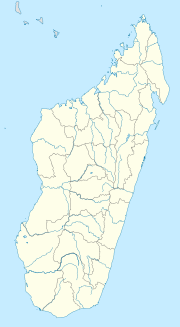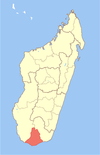Ambovombe-Androy
Ambovombe-Androy
Ambovombe | |
|---|---|
| Coordinates: 25°10′35″S 46°05′00″E / 25.17639°S 46.08333°E | |
| Country | |
| Region | Androy |
| District | Ambovombe-Androy |
| Population (2018) | |
| • Total | 114,230 |
| Time zone | UTC3 (EAT) |
| postal code | 604 |
Ambovombe-Androy [ambuˈvumbe ˈaɳɖʐuj], or just Ambovombe, is a city in the far south of Madagascar, and the capital of the Androy region. Ambovombe has now acquired city status with an officially estimated population in 2018 of 114,230.[1]
The city is connected by the Route nationale 13 with Taolagnaro (110 km) to the east. The RN 13 also leads north to Ihosy (383 km), and the Route nationale 10 north-west to Toliara, but these roads are in bad condition.
Agriculture[edit]
There are commercial sisal plantations near this town.
Catharanthus roseus is endemic to this region of southern Madagascar and is produced on farms around Ambovombe-Androy and Fort Dauphin. The plant is exported from this area and then used as a natural source of the alkaloids used to make vincristine, vinblastine and other vinca alkaloid cancer drugs.[2][3][4]
References[edit]
- ^ Institut National de la Statistique, Antananarivo.
- ^ Andriamanalintsoa, Jean Joseph (1995). Contribution a l'etude de la producition de la pervenche de Madagascar ou Catharanthus roseus, Cas d' Ambovombe, d'Amboasary-sud, de Beloha et Tsihombe (PhD Dissertation) (in French). Antananarivo, Madagascar: Universityersité d'Antananarivo, Ecole Superieur des Sciences Agronomiques.
- ^ Neimark, Benjamin (2009). "At the "Pharm" gate: The case study of the rosy periwinkle (Catharanthus roseus)". Industrial Heartlands of Nature: The Political Economy of Biological Prospecting in Madagascar (PhD Dissertation). New Brunswick: Rutgers, The State University of New Jersey. p. 70-112. doi:10.7282/T3WD40Q7.
- ^ Neimark, Ben (2012). "Green grabbing at the 'pharm' gate: rosy periwinkle production in southern Madagascar". The Journal of Peasant Studies. 39 (2): 423-445. doi:10.1080/03066150.2012.666975. S2CID 153584071. Retrieved 14 July 2023.


